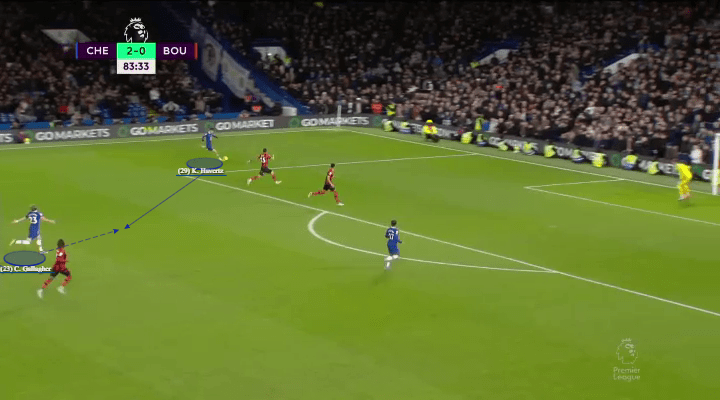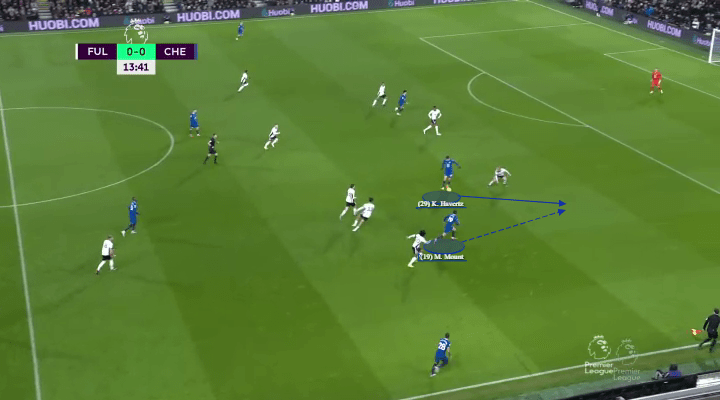Since suffering defeat to his old club at the end of October, Graham Potter’s Chelsea have lost seven of their last eleven matches. Injuries have evidently played a part, but Potter’s problems persist even despite a wealthy eleven still at his disposal. The balance of the team remains up in shambles, even despite a recent redemption victory against Crystal Palace. With that, we examine what’s wrong with Potter’s Chelsea from a tactical perspective, and how the former Brighton man can turn his fortunes around.
BALANCE OF THE TEAM
Embed from Getty ImagesKnown for chopping and changing his eleven at Brighton, Potter has failed to establish any sense of consistency in personnel and even principles of play since that horrific 4-1 defeat to his former club.
He’s unquestionably unsure of his best eleven, and his players look just as confused as all of us as onlookers. To his credit, this is something Thomas Tuchel achieved from the moment he entered the door with the Blues. His principles of play were clear and succinct in a 3-2-5 attack that would shift into a 5-2-3 to 3-4-2-1 in defense. Players had a clear understanding of their role, without limiting creativity and imagination in the final third of players like Mason Mount and Kai Havertz.
Embed from Getty ImagesIn fact, the freedom of movement between Mount, Havertz and Werner played an essential part in that run to the UEFA Champions League final in his first season. But he always had the sound structures in place and a rigid 3+2 rest-defense that remained excellent at breaking up the play.
Potter’s essentially doing what people think Spalletti’s pulling off at Napoli. The difference is that while Napoli have clearly defined principles of play that fanalysts are choosing to ignore, Chelsea have few over-arching strategies that are staying consistent from one game to the next. From the outside looking in, that lack of a rigid structure seems to be causing confusion and disorganization at every phase.
In attack, it’s not uncommon for the likes of Gallagher, Mount and Ziyech to compete for the same positions. Unfortunately, all of those positions are also ones that Kai Havertz likes to adopt as he drifts toward the side of the ball. In defense, they’re leaving too many gaps as they over-press the player in possession with too many numbers around the situation. Luckily for Potter, he can still turn his fortunes around if he can find the right balance in his team.
DEFENSIVE STRUCTURES
Embed from Getty ImagesChelsea have been relatively woeful in defense since that 4-1 defeat to Brighton, conceding 19 goals in that 12 match span. It’s not just a matter of poor organization or a lack of proper implementation within their intended rest-defense. I’d even go as far as to say that it’s a matter of personnel. You might suggest that injuries have played a part, and I would likely agree. But the strongest of managers know when to drop players when they are not performing. It’s something Erik Ten Hag‘s done brilliantly this season.
Embed from Getty ImagesThis extends all the way to the back end of the pitch where Kalidou Koulibaly has severely struggled to adapt to life in the Prem. His preeminent problem lies within an incessant desire to sprint out like a freight train to every situation. It’s Harry Maguire-esque in unnecessarily stepping out to be the hero and pressure a situation, without the regard for proper scanning. The main difference is that Koulibaly is so aggressive in his approach that he’s causing fouls, on top of taking himself out of the game.

That has not been anything new. The same problems persisted under Thomas Tuchel. But Potter’s team have persisted in playing Koulibaly when his form has been out of sorts since the start of the season. Now that Benoît Badiashile’s at the club, we may see a more calm and composed centre-half pairing at the back. Badiashile is an excellent partner for the slightly more robust defensive style of Thiago Silva, as both an excellent sweeping presence and a player that knows how to time his challenges to perfection.
Embed from Getty ImagesReece James and Ben Chilwell have been missed at full-back, but you still have one of the league’s most highly-rated left-backs in Marc Cucurella, and one of the Premier League’s all-time greatest defenders in Cesar Azpilicueta. It’s true that neither are at their very best right now, but that’s still an incredible amount of experience and defensive knowhow to keep a clean-sheet nearly every single week with the right defensive principles in place. Thomas Tuchel managed exactly that, albeit with Antonio Rüdiger and Edouard Mendy. Kepa’s had some positive performances, but I’d still question if he’s a better all-around keeper than Mendy.
MIDFIELD FLOATERS
Embed from Getty ImagesIn midfield, Potter must get the chemistry right between Mason Mount and all the floating pieces around him. Playing Jorginho and Conor Gallagher as a midfield pairing means that the rest-defense will naturally lack an additional member, as Gallagher gallivants forward. The British midfielder should never be restricted to a purely defensive role, as he’s exceptional at timing his runs forward and relentlessly using his energy to trouble the opposition.

The problem is that Mount also offers a lot of the same qualities, and operates in Gallagher’s best position. He too is a relentless presser, a decent creator, and an off-the-ball mover and shaker. It’s becoming hard to emphasize one without silencing the other, and Mount’s often been the one to fall silent. Throw someone like Hakim Ziyech into the mix and you get another creative player that naturally has inclinations toward drifting inside on that beauty left-foot he offers.
Embed from Getty ImagesIt’s undeniable that Chelsea miss the balance Raheem Sterling can provide on the other side through sheer pace and power. But an attacking trio of Mount, Gallagher and Ziyech should be enough to trouble any defense if each of them have a clear understanding of their role, and how to float in response to another.
Without Sterling, Potter has to be brave enough to test out Gallagher as the ’10’ and play Mason Mount off the left like the Thomas Tuchel days in that 3-4-2-1. It would massively benefit the former Palace man’s powerful running in behind, without forcing him to pick up possession in a position that’s already best suited to Mateo Kovacic and Jorginho.
USE OF HAVERTZ UP TOP
Embed from Getty ImagesAt the front end of the pitch, Kai Havertz is a wonderful player, who just needs the right resources. Although he played the part of ‘False 9’ for Tuchel to decent effect, we may just have to accept is best as a ‘Target’. He’s consistently coming wide to receive the ball and play nice one-two’s, and then the wrong players are in the box when it should be the German finishing off the chances. Chelsea’s best moments against Palace came when they used him as a traditional ‘Target’, and it’s no surprise that they scored their only goal through a wonderful Ziyech cross into that powerful noggin he possesses.
Embed from Getty ImagesAs we discussed in our article all about ‘Targets’ like Giroud and Haaland, that type of role is not as restrictive as it may sound. ‘Targets’ still link play, hold the ball up, and play-make for others. The difference is that they tend to do so from a centrally-focused role, where they are then in the right place to finish off the chances. They float far less than someone like Kai Havertz as that ‘Creative Link’, and they’re tasked with using their physicality more than their silky smooth moves. This is a role Kai Havertz could play if Chelsea were willing to use him in that way. It would massively benefit the chance creation of players like Ziyech and James, while serving all the floatations going on around him from players like Gallagher and Mount.

Moving forward, Chelsea should not shy away from using Havertz as more of a ‘Target’, integrating the composed defending of Badiashile into their ranks, and ensuring there’s enough balance in their rest-defense if Gallagher is to play as part of a double-pivot. Otherwise, you could easily play Mateo Kovacic as a holding presence alongside Jorginho, allowing the Croatian to still enact occasional moments of brilliance in pushing up the field. If Potter can implement some of these changes and restore balance to his team, we may start to see a more free-flowing Chelsea attack, and players having a clear understanding of their role.
Embed from Getty Images
So there it is! How Graham Potter can turn his fortunes around at Chelsea, even despite all their injury woes. Be sure to check out more of our Team Analyses, and follow on social media @mastermindsite. Thanks for reading and see you soon!
YOU MIGHT ALSO ENJOY…
Game of Numbers #26 – James Ward-Prowse & West Ham on the break
Despite Brighton’s high-flying start to the season, I worried about what would happen when faced with a truly great counter-attacking side, given the space out wide in their shape. Well, in came West Ham United, one of the best counter-attacking teams in the world. Here is Game of Numbers #26, starting with how West Ham…
Emma Hayes – Chelsea – Tactical Analysis (2022-23)
Over the past decade, few managers in the world of football have achieved more than Emma Hayes at Chelsea. Having now won the FA Cup and WSL title in back to back seasons with the Blues, the Chelsea legend will now have her eyes on the greatest prize of all in club football – the…
Potter’s first match at Chelsea – Tactical Analysis
In my entire existence on this website, I have never received so many questions about the same topic in a span of less than twenty-four hours. What, on earth, were Chelsea doing on Wednesday? What formation were they playing? What was Sterling? What was Cucurella? How did it all come together in such strange fashion?…




